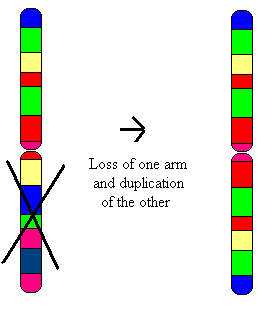
Isochromosome
Encyclopedia
An isochromosome is a chromosome
that has lost one of its arms and replaced it with an exact copy of the other arm. This is sometimes seen in some females with Turner syndrome
or in tumor
cells. This may also cause an isochromosome to have two centromeres (Tobias, 2011)

The chromosome arm is already copied during S phase of the cell cycle. During mitosis (or meiosis I or II), the sister chromatid sets line up along the midline in metaphase. The affected chromosome simply lines up at a right angle to its normal position, and as anaphase begins, the centromere is divided in the opposite plane from all the other chromosomes. This leaves the two long arms together and the two short arms together. The two new mirror-image chromosomes are pulled into opposite daughter cells. This produces two cells, each lacking one arm (e.g. the short arm) and containing an extra arm (e.g. the long arm) of the affected chromatid (or vice versa).It can also be formed by exchange involving one arm of a chromosome and its homolog(or sister chromatid)at the proximal edge of the arm,adjacent to the centromere.
If the chromosomal material contains imprinted genes, there will either be a deletion or duplication of the genetic material (genes on the arm lost are deleted, genes on the arm mirrored are duplicated).
Chromosome
A chromosome is an organized structure of DNA and protein found in cells. It is a single piece of coiled DNA containing many genes, regulatory elements and other nucleotide sequences. Chromosomes also contain DNA-bound proteins, which serve to package the DNA and control its functions.Chromosomes...
that has lost one of its arms and replaced it with an exact copy of the other arm. This is sometimes seen in some females with Turner syndrome
Turner syndrome
Turner syndrome or Ullrich-Turner syndrome encompasses several conditions in human females, of which monosomy X is most common. It is a chromosomal abnormality in which all or part of one of the sex chromosomes is absent...
or in tumor
Tumor
A tumor or tumour is commonly used as a synonym for a neoplasm that appears enlarged in size. Tumor is not synonymous with cancer...
cells. This may also cause an isochromosome to have two centromeres (Tobias, 2011)

The chromosome arm is already copied during S phase of the cell cycle. During mitosis (or meiosis I or II), the sister chromatid sets line up along the midline in metaphase. The affected chromosome simply lines up at a right angle to its normal position, and as anaphase begins, the centromere is divided in the opposite plane from all the other chromosomes. This leaves the two long arms together and the two short arms together. The two new mirror-image chromosomes are pulled into opposite daughter cells. This produces two cells, each lacking one arm (e.g. the short arm) and containing an extra arm (e.g. the long arm) of the affected chromatid (or vice versa).It can also be formed by exchange involving one arm of a chromosome and its homolog(or sister chromatid)at the proximal edge of the arm,adjacent to the centromere.
If the chromosomal material contains imprinted genes, there will either be a deletion or duplication of the genetic material (genes on the arm lost are deleted, genes on the arm mirrored are duplicated).

